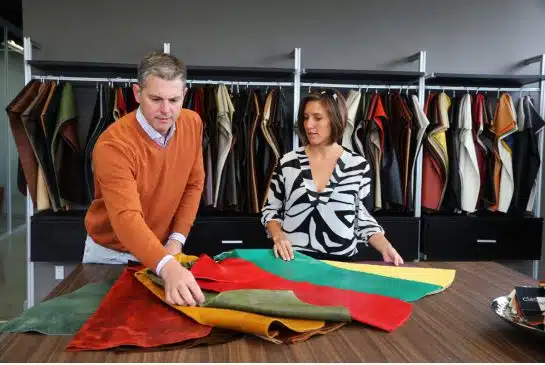Update: What a beef-free diet has done to leather prices

What a beef-free diet has done to leather prices
With the price of raw hides rising dramatically, as much as 30 per cent in the last year, leather is threatening to return to its roots as a luxury product.
COLIN MCCONNELL / TORONTO STAR Order this photo
Cristina Gabbrielli and husband Richard Harvey, pictured at their CTL Leather factory showroom in Scarborough, say global leather prices are rising as demand outstrips supply.
By: Ashante Infantry Business reporter, Published on Fri May 23 2014
Leather may not be in season, but delaying the purchase of that new jacket or sofa could end up costing you more.
With the price of raw hides rising dramatically, as much as 30 per cent in the last year, leather is threatening to return to its roots as a special purchase, as retailers begin to pass those hikes on to consumers.
“We’re trying to keep prices down, but it’s really difficult and you have to be an extremely creative buyer of leather,” said Roots co-founder Michael Budman about the “most extreme” material increases the fashion and lifestyle brand has encountered in its 40 years.
“We’re giving the consumer a very fair market deal to start with and I think they’ll understand.”
At The Chesterfield Shop chain, prices of all leather loveseats and sofas are up 25 per cent, said co-owner Steve Freedman. Twenty years ago, leather represented almost 100 per cent of the company’s inventory; now it’s 50 per cent, partly because of higher prices.
“I was speaking to one of my suppliers this morning and she was saying they can’t even honor their prices from month to month, because all she can see is that it’s going to keep on going up and up,” said Freedman.
He forecasts the pendulum swinging back three decades to when 5-10 per cent of upholstery buying was leather. Until recently, thanks to manufacturing innovations and a high supply of affordable raw material the figure had ballooned to 35-40 per cent, Freedman said.
“The sense I get is that leather is going to not be an everyday common purchase; it’s going to be looked at as a luxury item, like it was in the 1980s,” Freedman predicted. “The gap between fabric and leather has widened again to a significant level.”
At Montreal’s Elran Furniture Ltd., one of the country’s veteran manufacturers, vice-president Eric Abecassis is anticipating cancelled retail contracts and a jump in fabric orders, due to the “grotesque increases” in the price of leather.
His company produces 3,500 sectionals, recliners and chairs each week for the likes of Sears and The Chesterfield Shop.
“They understand, but a lot of my retailers can’t afford to support the increases needed,” said Abe cassis. “You cannot make the market absorb that; it’s got to come out of our margin, out of the retailer’s margin, and hopefully some increase in my wholesale prices and some increase at retail.”
There are overlapping reasons for the high-demand, low-supply situation described to explain surging leather prices.
The beef industry’s rising costs for feed, energy, land and transportation, along with a societal drift away from meat-heavy diets, have resulted in global meat consumption stagnating or falling overall.
Additionally, the U.S., the world’s largest beef producer, realized a 9 per cent drop in consumption from 2007 to 2012, according to the Food and Agriculture Organization of the United Nations.
And, with the Texas cattle herd still recovering from a bitter 2011 drought, slaughter is down 6 per cent, marking America’s “lowest cattle population since 1951,” said Hidenet.com analyst Don Ohsman who estimates the global leather market at $20 billion (U.S.).
The end result is less beef means less leather.
At the same time, a growing middle class in countries like India and Vietnam is fuelling the appetite for more leather goods and record car production in China and the economic recovery in Europe have increased demand for leather automotive seating. Luxury carmaker Bentley Motors has even recently launched a high-end handbag collection and said it plans expanding into new product lines and utilizing more leather.
Add to this upheaval, a falling Canadian dollar, strong Euro and higher costs for freight and containers and the price of leather skyrockets for Canadian manufacturers who either purchase directly from tanneries (who buy from slaughter houses and meat producers) or wholesalers like Toronto’s CTL Leather.
Although the automotive industry represents just 15 per cent of leather consumption, according to Hide net, the car makers have deeper pockets and generally get first dibs on raw material over upholstery (12 per cent) and the other big players — footwear (50 per cent), garments (8 per cent) and gloves (5 per cent).
“Because there’s less of a supply out there, the leathers are going to the highest bidders, where at one time the residential (furniture makers) could bid a little bit higher, or maybe they weren’t being bid against,” said Freedman.
Cristina Gabbrielli, co-owner of CTL Leather, one of Canada’s leading vendors concurs. The North York company supplies finished leather to well-known automotive, hospitality and fashion brands. They carry over 500 different varieties of leather, ranging from $2.50 per square foot South American top-grain, durable enough for a family room sofa, to $10 per square foot supple European aniline, ideal for designer handbags. And those prices are up 20 per cent since January.
“Slaughter houses will cancel contracts with tanneries and go straight to automotive because they know they can get higher price,” she said. “That never used to happen. In (residential) they expect prices to remain within the year. I got an April price list with a 5 per cent increase over the previous month. I got a June price list with another 5 per cent increase.”
While some shoe or accessory manufacturers might cut costs by using a little less leather in their designs, others are relying on buyers’ committed to the finer things, said analyst Ohsman.
“It’s amazing to me how quickly consumers and everybody gets used to these prices,” he explained. “We’re all paying how much more for gasoline that we paid just a few years ago and we’re used to it?”
“Despite the economy, they’re still all willing to buy that $1,000 Coach purse,” added Gabbrielli.
At Roots, which manufactures in Canada with leathers purchased mostly from Italy, Budman doesn’t expect the demand for leather products to decrease as prices rise.
“Buy now,” he counseled. “Buy the best quality leather you can buy.”
Correction – May 24, 2014: This article was edited from a previous version that misspelled Roots co-founder Michael Budman’s surname.
Correction – May 29, 2014: This article was edited from a previous version that misstated the name of Elran Furniture Ltd. As well, the previous version misstated Eric Abecassis’s surname.



